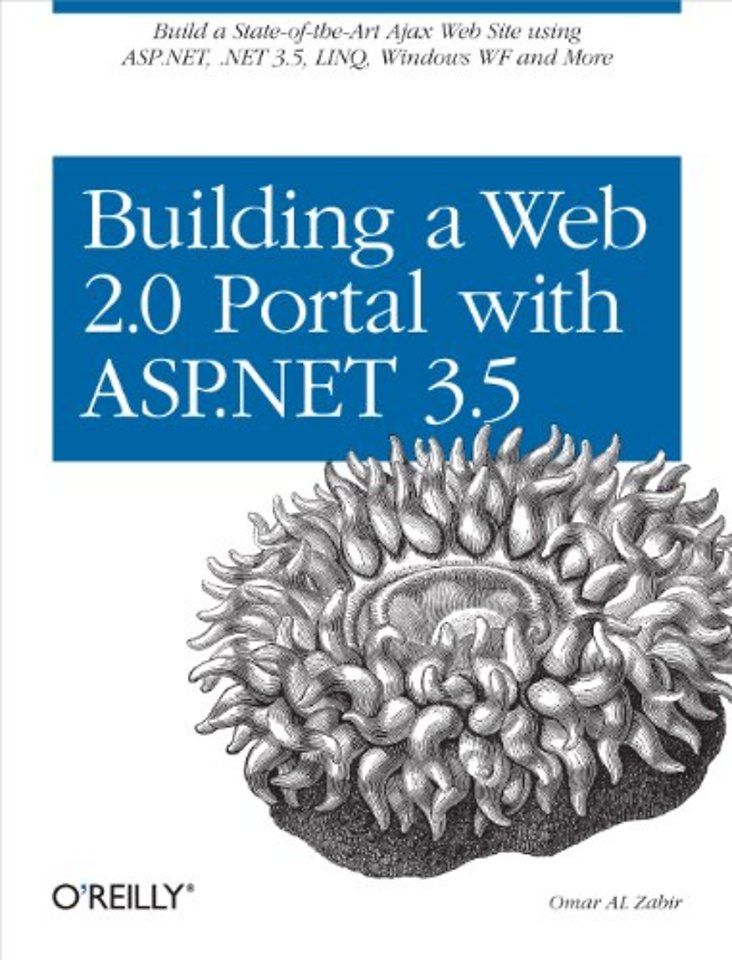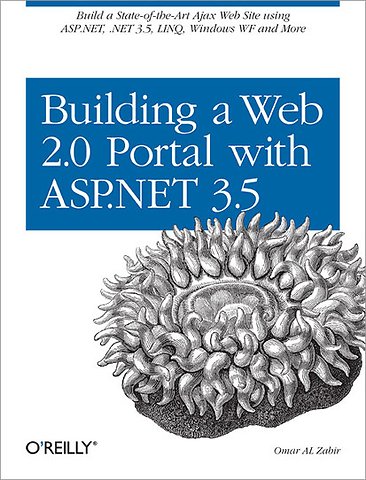Building a Web 2.0 Portal with ASP.NET 3.5
Paperback Engels 2008 9780596510503Samenvatting
If you think you're well versed in ASP.NET, think again. This exceptional guide gives you a master class in site building with ASP.NET 3.5 and other cutting-edge Microsoft technologies. You learn how to develop rock-solid web portal applications that can withstand millions of hits every day while surviving scalability and security pressures -- not just for mass-consumer homepages, but also for dashboards that deliver powerful content aggregation for enterprises.
Written by Omar AL Zabir, co-founder and CTO of Pageflakes, Building a Web 2.0 Portal with ASP.NET 3.5 demonstrates how to develop portals similar to My Yahoo!, iGoogle, and Pageflakes using ASP.NET 3.5, ASP.NET AJAX, Windows Workflow Foundation, LINQ and .NET 3.5. Through the course of the book, AL Zabir builds an open source Ajax-enabled portal prototype (available online at www.dropthings.com), and walks you though the design and architectural challenges, advanced Ajax concepts, performance optimization techniques, and server-side scalability problems involved.
You learn how to:Implement a highly decoupled architecture following the popular n-tier, widget-based application modelProvide drag-and-drop functionality, and use ASP.NET 3.5 to build the server-side part of the web layerUse LINQ to build the data access layer, and Windows Workflow Foundation to build the business layer as a collection of workflowsBuild client-side widgets using JavaScript for faster performance and better cachingGet maximum performance out of the ASP.NET AJAX Framework for faster, more dynamic, and scalable sitesBuild a custom web service call handler to overcome shortcomings in ASP.NET AJAX 1.0 for asynchronous, transactional, cache-friendly web servicesOvercome JavaScript performance problems, and help the user interface load faster and be more responsiveSolve scalability and security problems as your site grows from hundreds to millions of usersDeploy and run a high-volume production site while solving software, hardware, hosting, and Internet infrastructure problemsBuilding a Web 2.0 Portal with ASP.NET 3.5 also presents real-world ASP.NET challenges that the author has solved in building educational and enterprise portals, plus thirteen production disasters common to web applications serving millions of users. If you're ready to build state-of-the art, high-volume web applications, this book has exactly what you need.
Specificaties
Lezersrecensies
Inhoudsopgave
Who This Book Is for;
How This Book Is Organized;
What You Need to Use this Book;
Conventions Used in This Book;
Using Code Examples;
Safari® Books Online;
How to Contact Us;
Acknowledgments;
Chapter 1: Introducing Web Portals and Dropthings.OmarALZabir.com;
1.1 Defining a Web Portal;
1.2 Defining a Web 2.0 Portal;
1.3 Using a Web Portal;
1.4 Navigating Dropthings;
1.5 Using ASP.NET AJAX;
1.6 Using C# 3.0 and .NET 3.5;
1.7 Summary;
Chapter 2: Architecting the Web Portal and Widgets;
2.1 Object Model;
2.2 Using a Widget Framework;
2.3 Adding Widgets;
2.4 Maximizing the First-Visit Experience;
2.5 Rendering a Second-Visit Experience;
2.6 Improving ASP.NET AJAX Performance;
2.7 Adding Authentication and Authorization;
2.8 Preventing Denial-of-Service Attacks;
2.9 Summary;
Chapter 3: Building the Web Layer Using ASP.NET AJAX;
3.1 Implementing the Start Page of a Web Portal;
3.2 Building a Custom Drag-and-Drop Extender for a Multicolumn Drop Zone;
3.3 Implementing WidgetContainer;
3.4 Building Widgets;
3.5 Page Switching: Simulating a Nonpostback Experience;
3.6 Using the Profile Object Inside a Web Service;
3.7 Implementing Authentication and Authorization;
3.8 Implementing Logout;
3.9 Summary;
Chapter 4: Building the Data and Business Layers Using .NET 3.5;
4.1 Introducing LINQ to SQL;
4.2 Building the Data Access Layer Using LINQ to SQL;
4.3 Introducing Windows Workflow Foundation;
4.4 Building the Business Layer Using WF;
4.5 Implementing the DashboardFacade;
4.6 Summary;
Chapter 5: Building Client-Side Widgets;
5.1 Delaying Server-Side Widget Loading;
5.2 Content Proxy;
5.3 Building a Client-Side RSS Widget;
5.4 Building a Client-Side Flickr Widget;
5.5 Summary;
Chapter 6: Optimizing ASP.NET AJAX;
6.1 Combining Multiple Ajax Calls into One Call;
6.2 Timing and Ordering Ajax Calls to the Server;
6.3 Using HTTP GET Calls Instead of HTTP POST;
6.4 Working with the this Function;
6.5 Summary;
Chapter 7: Creating Asynchronous, Transactional, Cache-Friendly Web Services;
7.1 Scalability Challenges with Web Services;
7.2 Asynchronous Web Methods;
7.3 Modifying the ASP.NET AJAX Framework to Handle Web Service Calls;
7.4 Developing Your Own Web Service Handler;
7.5 Making an Asynchronous and Cache-Friendly Proxy;
7.6 Scaling and Securing the Content Proxy;
7.7 Summary;
Chapter 8: Improving Server-Side Performance and Scalability;
8.1 Instrumenting Your Code to Identify Performance Problems;
8.2 Optimizing the HTTP Pipeline;
8.3 Optimizing ASP.NET 2.0/3.5 Before Going Live;
8.4 Optimizing Queries in the ASP.NET Membership Tables;
8.5 Optimizing the ASP.NET 2.0/3.5 Profile Provider Before You Go Live;
8.6 ASP.NET Production Challenges;
8.7 Redirecting Traffic from an Old Web Site to a New One;
8.8 Summary;
Chapter 9: Improving Client-Side Performance;
9.1 Understanding Web Caching;
9.2 Content Delivery Networks;
9.3 Optimizing Internet Explorer JavaScript Performance;
9.4 Reducing the Web Service Call Payload;
9.5 Loading the UI on Demand;
9.6 Using Read-Ahead Caching for Ajax Calls;
9.7 Hiding HTML Inside <textarea>;
9.8 Summary;
Chapter 10: Solving Common Deployment, Hosting, and Production Challenges;
10.1 Deploying Your Web Site in a Web Farm;
10.2 Thirteen Production Disasters That Could Happen at Anytime;
10.3 Choosing the Right Hosting Provider;
10.4 Choosing a Web Site Monitoring Tool;
10.5 Configuring Proper Performance Counters;
10.6 Summary;
Colophon;
Rubrieken
- advisering
- algemeen management
- coaching en trainen
- communicatie en media
- economie
- financieel management
- inkoop en logistiek
- internet en social media
- it-management / ict
- juridisch
- leiderschap
- marketing
- mens en maatschappij
- non-profit
- ondernemen
- organisatiekunde
- personal finance
- personeelsmanagement
- persoonlijke effectiviteit
- projectmanagement
- psychologie
- reclame en verkoop
- strategisch management
- verandermanagement
- werk en loopbaan

